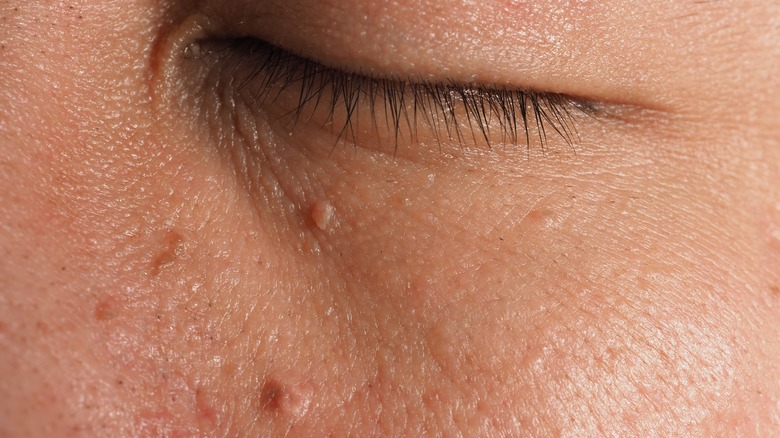Can A Skin Tag Fall Off On Its Own?
Skin tags are small growths that can appear on the skin, according to Medical News Today. They're composed of loose collagen fibers and blood vessels. While they can be found all over the body, most of the time, skin tags are found on areas of the body that rub together, such as the underarms, neck, and groin, among other parts. Skin tags are typically small, ranging from 2 mm to 5 cm in size, and are usually flesh-colored or a little darker. Luckily, they're benign, meaning they're not cancerous and do not threaten your health.
However, they are common in people with diabetes or those who are overweight. In addition, the exact causes of skin tags are unclear. Fortunately, they are not contagious. Therefore treatment isn't necessary. But if you have a skin tag that is causing discomfort in your daily life or needs removing for cosmetic reasons, you may have it removed by a dermatologist or other healthcare provider. On the other hand, some people may wonder if skin tags could diminish or simply fall on their own over time. Here's what we know.
A skin tag may or may not fall on its own
Turns out, some skin tags may fall off on their own, as per the National Health Service (NHS). This might happen if the tissue doesn't have enough blood supply or is twisted. In other cases, skin tags that are constantly touched or tugged often dry out, which results in them falling by themselves, according to Familydoctor.org. Keep in mind, irritated tags are often located in areas of the body that are prone to rubbing. On the other hand, when the skin tag is large in size, painful, or bleeds when it falls off, it is important to consult a healthcare provider for further evaluation (via Medical News Today).
However, if clothing is constantly bothering the skin tag, it might be best to avoid wearing tight garments. Unfortunately, there is no way to ward off skin tags (per Familydoctor.org). Instead, it's best to maintain a healthy weight since skin tags are more common in people who are overweight. In addition, the experts at the Cleveland Clinic advise engaging in regular exercise and avoiding jewelry that rubs against the skin.
How are skin tags removed?
Luckily, there are several ways to remove skin tags, including surgical removal, according to Healthline. A healthcare provider can use surgical scissors to cut off the skin tag. This is usually done in a medical office or clinic. Another removal method is cryotherapy. Cryotherapy involves using a cold substance, such as liquid nitrogen, to freeze the skin tag. Ligation is yet another method of removal. This involves tying up the tag with a strand to cut off the blood supply. Lastly, some may consider electrosurgery, which uses electric currents to get rid of the small growths.
Regardless of which method you go with, it is important to consult with a healthcare provider before attempting to remove a skin tag, as incorrect removal can cause excessive bleeding or infection, says Medical News Today. Plus, the doctor will need to assess the skin tag to determine the best method of removal and advise you on how to care for the area after the procedure.



